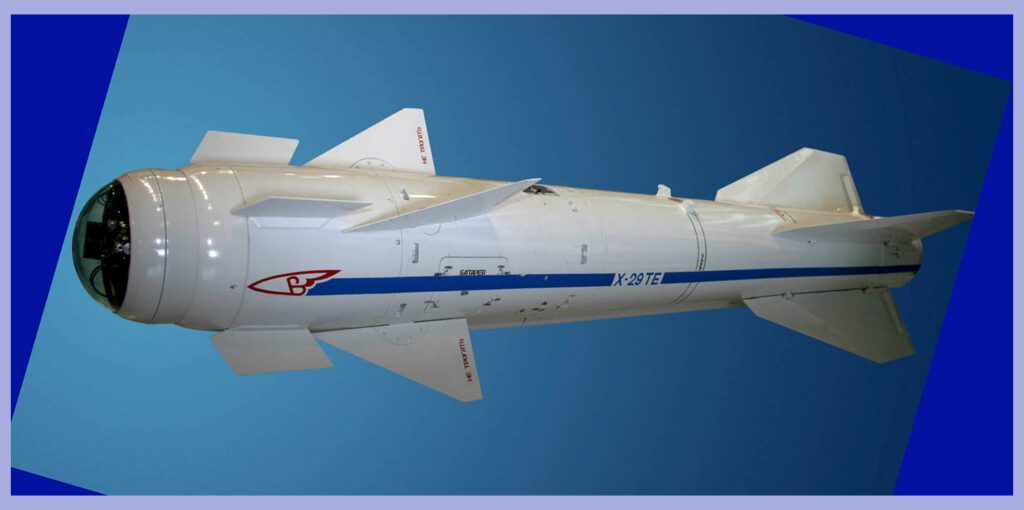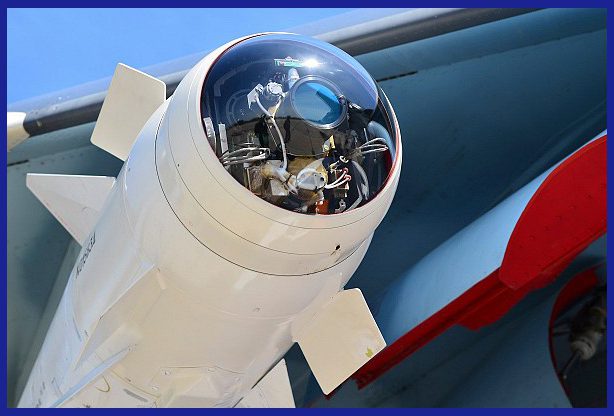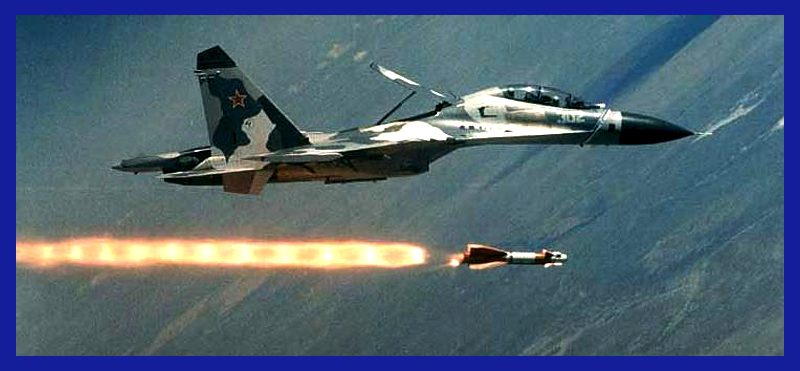The Kh-29 Kedge ASM stands as a testament to Soviet/Russian engineering prowess, combining long-range precision with devastating firepower. Let’s Delve Into The Details Of The Kh-29 Kedge ASM, also known as NATO As-14 Kedge. The Soviet/Russian Air-To-Surface missile (ASM) is a powerful tool designed to take on ground targets with great effectiveness. First introduced in the late 1970s, the Kh-29 replaced earlier models like the Kh-23 Grom. With a range of up to 30 km and a massive warhead of 320 kg, the Kh-29 packs a serious punch.
Its choice of laser, infrared, active radar, or TV guidance makes it an incredibly versatile weapon. This ASM is typically carried by tactical aircraft like the Su-24, Su-30, MiG-29K and Su-25, giving these aircraft an unmatched and expanded standoff capability.
The Kh-29 ASM boasts a cylindrical body with four large control surfaces at the rear and a small set of wings at the front. It is fueled by a powerful solid rocket motor and has a high-explosive fragmentation warhead capable of decimating targets with remarkable precision. The Kh-29 is primarily designed to eliminate larger battlefield targets and vital infrastructure such as industrial buildings, depots, and bridges, but it can also take down ships weighing up to 10,000 tonnes, hardened aircraft shelters, and concrete runways with devastating force. The Kh-29 has earned its stripes in numerous conflicts, including the Iran-Iraq War, the Syrian Civil War, And Presently on Russo-Ukraine War.

Analyzing The Design Of The Kh-29 Kedge ASM
The Kh-29 Kedge ASM exudes a distinctive and purposeful design, perfectly reflecting its role as an air-to-surface missile. The sheer aerodynamic layout of the Kh-29 draws inspiration from the renowned Molniya R-60 ( AA-8 ‘Aphid’ ), a testament to Molniya’s illustrious heritage in the field of air-to-air missiles. This remarkable weapon amalgamates the laser guidance head of the Kh-25 ( AS-10 ‘Karen’ ) and the TV guidance system from the Kh-59 ( AS-13 ‘Kingbolt’ ), complementing its formidable prowess with a prodigious warhead.
While the United States AGM-65 Maverick is often mentioned in the same breath as the Kh-29, it pales in comparison. The AGM-65 Maverick, diminutive in size and weighing less than half as much, is overshadowed by the Kh-29’s grandeur. In fact, the Kh-29 surges ahead with a staggering 20% higher top speed ( 1,150 km/h vs. 1,470 km/h ) and a warhead of monumental proportions ( 320 kg vs. 136 kg ), leaving its competitors in awe.

Let’s Analyze Its Design Features
- Body: The missile has a cylindrical body that is around 4 meters long and 0.38 meters in diameter. The body is made of aluminium alloy and has a smooth surface to reduce air resistance and improve aerodynamics.
- Control Surfaces: The missile has four large rectangular-shaped control surfaces at the rear that provide stability and control during flight. These surfaces are hinged and can be deflected to adjust the missile’s course.
- Wings: The Kh-29 has small wings at the front that provide additional lift and stability. These wings are swept back and have a delta-shaped configuration, which helps to improve the missile’s manoeuvrability.
- Warhead: The missile’s high-explosive fragmentation warhead is located at the front of the missile and can weigh up to 320 kg. The warhead is designed to penetrate through a target’s defences before detonating and causing damage.
- Guidance System: The Kh-29 can be guided by either infrared or laser homing systems, depending on the version. The guidance system is housed in the nose of the missile and uses sensors to lock onto a target.
- Propulsion System: The missile is powered by a mixed-thrust solid-fueled rocket motor that provides the necessary thrust for flight. The motor is located at the rear of the missile and is ignited when the missile is launched.
Overall, the design of the Kh-29 Kedge ASM is optimized for high-speed flight and manoeuvrability, as well as for penetrating through defences to reach and destroy ground targets. Its combination of guidance systems and warhead technology makes it a highly effective weapon system, despite its age.

Development of the Kh-29 Kedge ASM
The development of the Kh-29 Kedge ASM began in the late 1970s under the direction of the Molniya design bureau located in Ukraine. It represented the bureau’s sole foray into the domain of air-to-ground munitions. However, as the bureau redirected its focus exclusively towards space-related projects, the responsibility for further developing the Kh-29 was passed on to Vympel. In 1976, the inaugural launch of the missile took place, initiating a series of rigorous trials that ultimately led to the Kh-29’s official introduction into service in 1980. These significant historical milestones firmly establish the Kh-29 as a product of meticulous research and development efforts spanning several years.
Over the years, the Kh-29 has undergone numerous upgrades and improvements to further augment its already impressive capabilities. Various variants have been developed, featuring infrared or laser guidance systems that bestow exceptional flexibility in diverse operational scenarios. The missile has enjoyed extensive exportation to numerous countries, a testament to its wide recognition and demand. Its stellar combat performance and exceptional effectiveness have solidified its enduring utilization not only by the Russian military but also by other operators worldwide.

Later Generation Kh-29 Kedge Variations
Over the years, several variations and upgrades of the Kh-29 Kedge ASM have been developed to enhance its capabilities and adapt it to different operational requirements. Here are some notable later-generation variations:
- Kh-29L: This variant features semi-active laser guidance, which allows for more precise target engagement. It can home in on laser-illuminated targets with a limited range of a maximum of 10 km.
- Kh-29ML: This is an upgraded version of the Kh-29L.
- Kh-29T: This variant utilizes TV guidance, where the missile is guided by a television camera installed in the nose section. This allows the operator to visually track and guide the missile towards the target.
- Kh-29TE: This version represents an upgraded variant of the Kh-29T, showcasing improved electronics and enhanced target recognition capabilities. Additionally, it boasts an extended range when compared to its earlier counterparts. With a minimum range of 3 km and a maximum range of 30 km, this formidable missile can be launched from altitudes ranging from 200 m to 10,000 m. These advancements combine to provide unparalleled performance and versatility in engaging targets across varying distances and altitudes.
- Kh-29TD: This version stands as a dual-mode variant, seamlessly integrating both TV guidance and laser guidance systems. During the flight, it possesses the capability to effortlessly switch between these two modes, adapting to the availability of a laser designation or the requirement for visual tracking. Remarkably, this advanced variant showcases an impressive maximum range of 40 km, further extending its reach and effectiveness in engaging targets with unparalleled precision.
- Kh-29L/TE-I: This version is an upgraded variant of the Kh-29L/TE, featuring an improved seeker and increased resistance to electronic countermeasures. It is designed to effectively engage targets in complex and hostile environments.
These later-generation variations of the Kh-29 Kedge ASM offer improved guidance systems, extended range, enhanced electronics, and better target recognition capabilities. These upgrades make the missile more versatile, accurate, and effective in engaging a wide range of ground targets in various operational scenarios.

The Kh-29 Kedge, History Of Operations
The Kh-29 Kedge has a significant history of operations, being used by various countries in different conflicts. Here are some notable instances of its deployment:
- Iran-Iraq War: Both Iran and Iraq employed the Kh-29 during the Iran-Iraq War ( 1980-1988 ). Iraqi aircraft, such as the Mirage F1 and MiG-23, utilized the missile to strike Iranian ground targets, including infrastructure and military installations. Iran, in turn, employed the Kh-29 against Iraqi positions.
- Chechen Wars: The Kh-29 was used by Russian forces during the First and Second Chechen Wars ( 1994-1996 and 1999-2009 ). It was deployed against Chechen rebel positions, fortified structures, and other targets.
- Syrian Civil War: The Kh-29 has been employed by the Syrian Air Force in the ongoing Syrian Civil War. It has been used to target rebel groups, terrorist organizations, and infrastructure in various regions of Syria.
- Libyan Civil War: The Kh-29 has also seen use in the Libyan Civil War. It has been deployed by both government forces and various factions to engage ground targets in the conflict.
- Yemeni Civil War: The Kh-29 has been reported to be used in the Yemeni Civil War. It has been employed by Saudi-led coalition forces in airstrikes against Houthi rebel positions.
- 2022 Russian Invasion Of Ukraine: The Kh-29 missile has potentially witnessed limited utilization during the 2022 Russian invasion of Ukraine, reportedly being deployed from Su-34 aircraft. These formidable air-to-surface missiles may have been employed in targeted strikes, bolstering the offensive capabilities of the invading forces.
These are just a few examples of the Kh-29 Kedge’s operational history. The missile has been utilized in numerous conflicts worldwide, demonstrating its role as a prominent air-to-surface weapon system. Its effectiveness in engaging ground targets has contributed to its continued deployment by various military forces.

International Operators Of The Kh-29 Include
Presently, an impressive roster of 22 countries ( including Russia, China, Belarus, Indonesia and India ) is operating the formidable Kh-29 Kedge ASM. This proliferation highlights the widespread recognition of its power and effectiveness in modern warfare. Its deployment spans across nations, showcasing its versatility and adaptability in diverse operational contexts. The missile’s impact is felt on multiple continents, with operators leveraging its capabilities to project force, neutralize threats, and safeguard national security interests.
The Kh-29 Kedge Technical Specifications
- Weight: Kh-29L: 660 kg ( 1,460 lb ) / Kh-29T: 685 kg ( 1,510 lb ) / Kh-29TE: 690 kg ( 1,520 lb )
- Length: 12 ft 10 in ( 3.69 M )
- Diameter: 15 inch
- Warhead: High explosive (HE) armour-piercing warhead, weighing 320 kg ( 705 lb )
- Detonation: Explosive impact upon detonation
- Engine: Mixed-thrust solid-fueled rocket motor
- Range: Kh-29L: 10 km / Kh-29T: 12 km / Kh-29TE: 30 km / Kh-29TD: 40 km
- Speed: 2,200 Kmph ( Mach 1.78 )
- Guidance: Kh-29L: Semi-active laser guidance / Kh-29T/TE: Passive homing TV guidance / Kh-29D: Infrared-homing guidance
- Launch Platform: All operational Russian Fighter aircraft which include: Su-22, Su-25, Su-27, Su-30, Su-35, MiG-29K, MiG-35, Su-24, Su-34 and Su-57

“Moreover, it is worth noting that you have the unique opportunity to acquire an exceptional scale model of the Su-30 fighter jet, which is available on Amazon by simply clicking the provided link. This magnificent weapon system, which has demonstrated its devastating capabilities on the battlefield, is a testament to the Russian military’s unwavering commitment to advanced technology and precision warfare. With its compatibility with most Russian-origin aircraft, it is a formidable asset for any air force that operates these aircraft. The Kh-31 family of weapons represents a powerful arsenal in the hands of any nation’s air force.”
In conclusion, the Kh-29 Kedge ASM stands as a testament to its enduring power and strategic significance on the modern battlefield. With 22 countries presently operating this formidable weapon, its impact reverberates across the globe. From precision strikes to decisive engagements, the Kh-29’s lethal capabilities have cemented its position as a vital tool in the arsenals of nations seeking dominance and protection. Its widespread adoption showcases the trust placed in its advanced technology and unrivalled performance. As the world evolves, the Kh-29 Kedge remains an unwavering symbol of strength, ensuring that those who wield it possess an undeniable advantage in the complex landscape of contemporary warfare.

Important Announcement for Our Valued Readers!
After an article is published, it is possible that updates or changes may have occurred beyond the time of publication. Therefore, it is important to be aware that certain information in the article might be outdated. To ensure the most accurate analysis, it is highly recommended to verify the content with the latest sources available.
However, we are dedicated to delivering outstanding articles on military products and global updates. Maintaining quality and smooth operation requires resources. Your support sustains our efforts in providing insightful content. By purchasing high-quality products through our affiliated links, you help us keep our platform alive and acquire top-notch items. Your unwavering support is invaluable and inspires us to strive further.
We welcome your suggestions and requests for more information, as we value feedback from our readers. If there’s specific defence material or equipment not covered on our site, please share your request in the comments. We’ll strive to research and provide the required information. We sincerely thank you for your unwavering interest in our website, and we eagerly anticipate hearing from you! Enjoy your reading experience!
